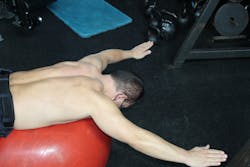Firefighters, like law enforcement and military personnel, are tactical athletes. Furthermore, like law enforcement and the military, the nature of firefighting is dangerous, and there is inherent risk. As such, your health, wellness and fitness significantly affect your ability to effectively perform your job.
As you take part in a training evolution or work out in the weight room, you should focus on how your preparation will help you in an emergency—and, thus, decrease your risk of injury. One way to do that is to strengthen your core muscles and to maintain that strength. A great deal of progress has been made in this area. However, there is one important part of the body that most firefighters don’t strengthen—the muscles that attach the shoulder blades to the rib cage.
Why is this problematic in your job? Imagine that it’s early morning when the tone goes off and you are dispatched to a house fire. As the rig turns the corner, you encounter thick, black smoke that’s pouring out of the house. You barely can see two feet in front of you as you enter the building. Upon searching a room on the second floor, your partner suddenly yells out that he/she partially fell through a hole in the floor. Instinctively, your partner broke the fall to the floor below by putting out both arms. Your partner needs help to be pulled out of the hole. Once you make your way to your partner, will you have the core strength within your trunk and your arms to help? When placed in an emergency situation such as this, your muscles instinctively should rely on your training and preparation.
As a firefighter, you continually learn and train to improve your knowledge, skills and muscle memory. You learn how and where equipment should be stored in its designated place. In addition, you are taught how to call a mayday well before you are placed in any real emergency situation. Activating and using the core muscles should be the same. The first time that you use these muscles shouldn’t be in an emergency. The core should be trained so that these muscles automatically help to provide stability, allowing you to perform your job duties safely and effectively.
Shoulder blades to rib cage
The core muscles are some of the most important structures to help to prevent work-related injuries, and they include all of the muscles that are within the upper back, the lower back and the abdominal region and that surround the hips and the pelvis. Most often overlooked and forgotten are the muscles that attach the shoulder blades to the ribcage, which is known as the scapulothoracic joint.
The scapulothoracic joint is one of four joints that make up the shoulder girdle. Often excluded from the core muscle group, the muscles that surround the scapulothoracic joint decrease risk of chronic and acute injuries to the neck, arms, upper back and lower back. These muscles play a significant role in the correct movement of the entire arm and help to maintain the shoulder in an ideal position. They also are responsible for transferring forces from the legs and other parts of the core to the arms.
Everything within the human body is connected; therefore, when one or more of the core muscles are weak, it places a lot of stress on the joints. With increased stress at any joint, there might be an increase in pain and risk of injury. Conversely, when the core muscles demonstrate appropriate strength and endurance, everything within the body works together. This isn’t limited to the muscles of the pelvis and trunk but also includes the scapulothoracic joint. Excluding the scapulothoracic joint from the core muscle group places the firefighter at increased risk of injury because of significant muscle imbalances.
Scapulothoracic strength
Exercises that target the core muscles should include the scapulothoracic joint as part of a well-rounded fitness program. In addition to your regular fitness training, these exercises should help to prepare you for any type of emergency situation, including maintaining awkward positions for extended periods of time; moving and lifting heavy objects; performing activities with uneven loads; and working in unstable environments.
As with any fitness program, variety also is important. Doing the same few exercises without making changes to your routine causes your strength and endurance to plateau and prevents further gains. By regularly incorporating different exercises into your fitness program that continuously challenge the core muscles in various directions and combinations, you will be able to perform your job better and be better ready for each emergency.
Three basic scapulothoracic strengthening exercises should be considered.
Scapular pushups
Start in a pushup position, with hands and feet on the floor and knees and elbows straight. Keeping the elbows straight throughout the exercise, bring your shoulder blades backward toward each other. Hold this position for about three seconds. Next, push your shoulder blades apart. Hold this position for an additional three seconds and repeat. Movement only should occur at the shoulder blades. Don’t strain the neck, don’t arch the back, and don’t move the spine or rotate the pelvis.Prone T’s
Start by lying face down on a firm surface, with a few pillows under your pelvis and a small towel roll under your forehead or with a large exercise ball under your pelvis. If possible, contract your abdominals by squeezing your stomach muscles together and try to bring your bellybutton toward your spine. The spine should remain straight, with the head and neck in a neutral position. The low back muscles should remain relaxed throughout the exercise.Bring both arms 90 degrees out to the sides to form a T position. Your palms should face the floor. Maintain your arms in this position throughout each repetition, moving only your shoulder blades throughout the exercise. Squeeze your shoulder blades backward toward each other, hold for three seconds, relax and repeat.
Prone Y’s
The starting position for this exercise is the same as the previous exercise. Lift your arms into a Y position, with your palms facing the floor. Contract the abdominal muscles, keeping the spine straight and the head in a neutral position. The low back muscles should remain relaxed throughout the exercise.Squeeze your shoulder blades together toward the spine and down toward the lower back simultaneously. Hold this position for three seconds before relaxing your shoulder blades. Maintain your arms elevated in the Y position throughout each repetition. While completing this exercise, motion only should come from your shoulder blades.
About the Author

Jessica Scott
Jessica Scott is a Doctor of physical therapy, a certified athletic trainer, and a tactical strength and conditioning facilitator. She received her undergraduate degree in athletic training and sports medicine and her Doctorate of physical therapy from Quinnipiac University. As the daughter of a firefighter, Scott grew up seeing the physical demands and requirements of the firefighting profession. Therefore, she started New England Tactical Sports Medicine, which is dedicated to improving the health and wellness of tactical athletes and provides rehabilitation services, educational seminars regarding injury prevention, and fitness programs to promote healthy lifestyles and improved physical performance.



